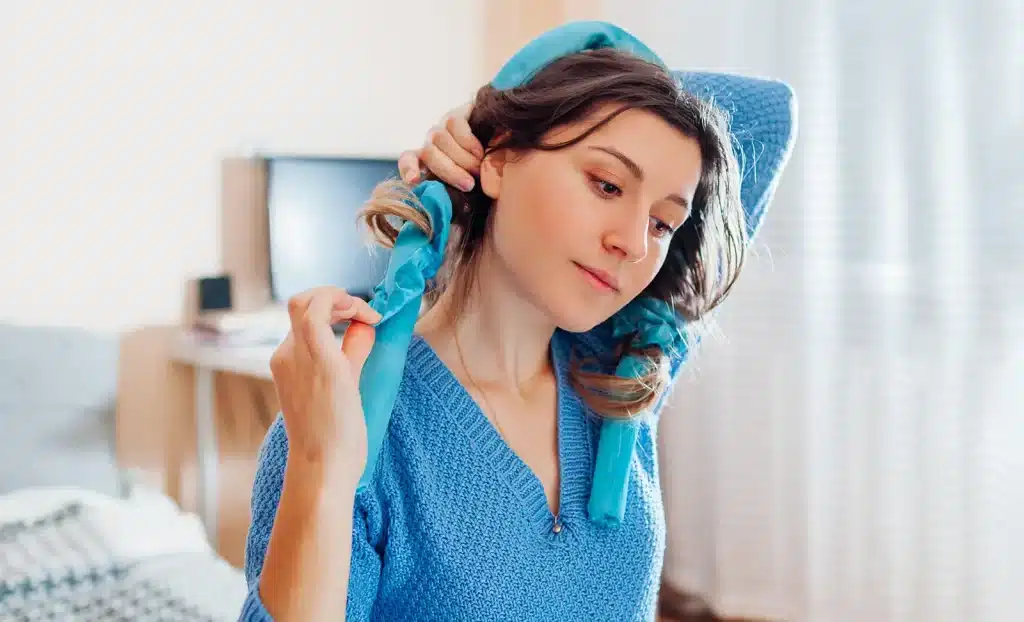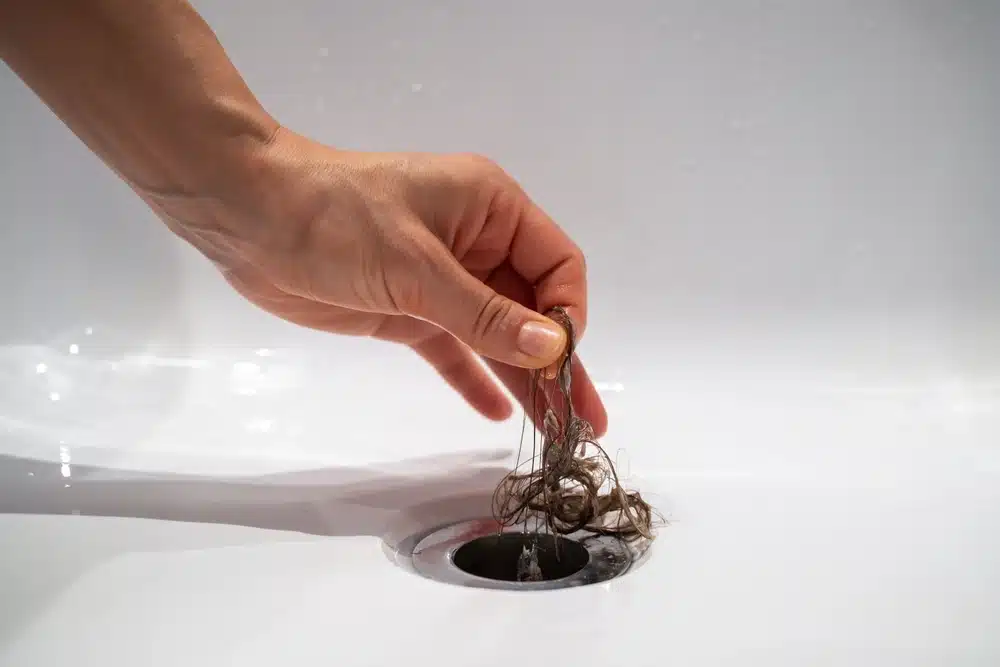A perm, short for a permanent wave, is a chemical treatment that changes the structure of the hair to create well-defined curls. They were particularly popular in the 1980s, revitalising people’s looks and giving them more confidence than ever. While perms are not as common today, many people still enjoy getting this treatment. The question is, will a perm damage your hair? Will a perm mean you need a hair loss treatment?
While perms are great for those wanting to add volume and style to their locks, there’s also an unfortunate truth: Yes, perms can cause significant damage to the hair, leading to breakage.
If you’re interested in learning more about perms and how they damage your hair, as well as ways to prevent and treat that damage, keep reading.
What is a Perm?
So, what exactly is a perm, and how does it work?
A perm is the process of breaking your hair’s disulfide bonds using a chemical treatment, [1] often ammonium thioglycolate, and then restyling it into curls, using the exact curl pattern you want with the right tools (for example, rollers). After this treatment, the perm lasts several months, and you can treat your hair as usual.
There are several types of perm techniques available; the right one for you depends on your hair type and end hair goals. The two most common are classic cold perms and hot perms. Then, some perms provide different results, such as body waves, spirals, and multi-textured perms.
The Process of Getting a Perm
Most salons have provided multiple hair perms, and the perm process for clients is usually as follows:
- Washing the Hair
The first step involves the hairstylist washing your hair, which is important as it removes any dirt and sebum build-up from the scalp.
- Wrapping the Hair
The next step involves wrapping the hair in rollers. The roller type depends on whether the preferred outcome is tighter ringlets or looser waves.
- The Chemical Treatment
Once the hair is in the rollers, the chemical process begins. The hairstylist applied the liquid chemical treatment to the hair through the strands, ensuring proper coverage.
- Waiting
The process at this stage usually takes around 20 minutes.
- Removing Curlers and Washing Hair
After waiting, the hairstylist will remove your hair from the curlers and wash your hair thoroughly, removing the chemical treatment.
- Neutralisation
The neutralisation step involves the hairstylist using a second chemical treatment to help the curls stay in place. They will follow that with a rinse.
- Deep Conditioning
Most hairstylists finish the perm process with deep conditioning treatments. This is so your hair looks and feels healthier and more nourished. Your hairstylist will also give you instructions following the perm, such as not getting your hair wet for 48 hours.
Remember that perm hair treatments may differ depending on your exact perm type and clinic. Following this process, you will have permed hair.
Will a Perm Damage Your Hair?
Yes, curly perming your hair will inevitably cause damage to your hair. The damage is quite extensive, as the chemical process involves breaking the hair’s structural bonds, making the hair’s structure weaker overall. This means the hair is more prone to dryness, frizz, split ends, and hair breakage.
Will a Perm Damage Your Hair Permanently?
The perm’s damage to the hair is permanent until that hair has grown out. While a perm won’t always affect the hair follicles or lead to permanent hair loss, the damage caused to the hair shaft is irreversible, even if deep conditioning treatments help the hair feel softer.
Will a Perm Damage Your Hair Follicles?
Sometimes, a perm may even damage your hair follicles. The chemicals used in a perm are very harsh, and if they are used close to the scalp, this can cause scalp irritation, burns, and, in some cases, scarring. Sometimes, this may even lead to damaged hair follicles that can no longer produce new healthy hair strands.
How to Perm Your Hair with Minimal Damage
Do you still want to get a perm despite the damage? Here are some tips.
Choose the Right Hairstylist: The right hairstylist makes all the difference. Don’t just choose any salon – pick one with a good reputation, one that knows what they are doing.
Pick a Gentler Perm: You don’t need to pick the harshest perming solutions to achieve your desired look. To minimise damage, opt for a gentler perm.
Consider Your Hair Type: When getting a perm, consider your hair type. Do you have fine, straight hair that’s susceptible to breakage? If so, go for a gentler formula for your strands.
Don’t Colour and Perm on the Same Day: You shouldn’t overwhelm your hair by treating your freshly coloured hair to a perm. Instead, always wait at least two weeks between these treatments.
Follow a Good Hair Care Routine: Your hair needs extra care following a perm, so create and follow a good hair care routine. We will go into how to treat your damaged hair following a perm further down the road.
You might wonder, will a perm damage your hair if you take proper precautions? The answer is still, unfortunately, yes. Perm chemicals are simply damaging to all hair strands, and there is no getting away from that.
How to Treat Perm Damaged Hair
So, you have already opted for a perm, noticed your hair is damaged, and want to save it as much as possible? Here’s what you should do.
Moisturise Regularly: Your perm-damaged hair is in desperate need of moisture. So, use a deep conditioning hair mask on your strands regularly, at least once a week. You can also use nourishing hair oils such as argan or olive oil to boost hydration.
Avoid Heat Styling: The last thing you want to do is cause more damage, so avoid styling your hair with heat. If you must use heat, say for a special occasion, use a high-quality heat protector spray beforehand.
Use a Protein Treatment: While you cannot build your hair’s structure from scratch, a protein treatment may help strengthen the structure, giving your hair more resilience.
Get Regular Trims: The ends of your hair will be the most damaged (especially if you’ve had several perms over the years), and the best way to fix this is by getting regular trims. Your hair will grow over time, and the new hair that hasn’t seen as many chemical treatments will be much healthier!
Struggling with hair loss? Download our hair track app.
Are Perms Worth it?
That is a hard question to answer, as it’s up to the individual whether or not a perm is worth it. If the results of a perm make a person feel more confident, and they feel the curls are tied to their identity, then the chances are it is worth it. The best route here is to always be responsible when getting the hair permed and to follow proper care instructions.
For those toying with the idea, it might be best to choose against getting a perm due to the extensive damage it can cause. Remember, you can always achieve similar results when you want to with hair styling products, and there are even heat-free ways to curl your hair, such as with sock curls or braids.
What if You’ve Experienced Hair Loss?
Experiencing hair loss can be devastating. The first step is understanding what has caused it. If it is your perm that’s causing breakage, it’s crucial to stop perming your hair. Moisturising treatments may help, but sometimes you will need to cut off the damaged areas and wait for your hair to grow.
Damaged hair follicles are a separate issue. In this case, you may need to look into other hair restoration options, such as minoxidil, a hair loss medication that increases blood flow to the scalp and encourages new growth. Non-surgical clinical treatments can massively help with hair loss, such as PRP (platelet-rich plasma), low-level laser therapy, and microneedling. These can be particularly helpful for damaged follicles that aren’t quite dead yet, as the processes may activate the follicles and lead to new growth.
For more extensive hair loss – especially genetic hair loss – a hair transplant is the best route. Hair transplants are minimally invasive surgical procedures that require the skilled hands of a surgeon to take healthy hair follicles from a donor area and transplant them to the recipient area. The results last a lifetime.
Do Perms Damage Your Hair? Final Thoughts
Perms are extremely damaging to the hair, as the chemicals change the structure of the strands. There’s no getting away from this. In some cases, perms can damage the follicles and prevent new growth. If you are still intent on getting a perm, you must know the risks and follow instructions to ensure your perm causes as little damage as possible, which is key to keeping your beloved locks!
Are you interested in starting a hair restoration journey? If you’ve experienced hair loss that you want to reverse, our team is here to help. Check out our patients gallery to see what our incredible hair expert team can do.
Sources:
- https://www.webmd.com/beauty/what-to-know-hair-perms




